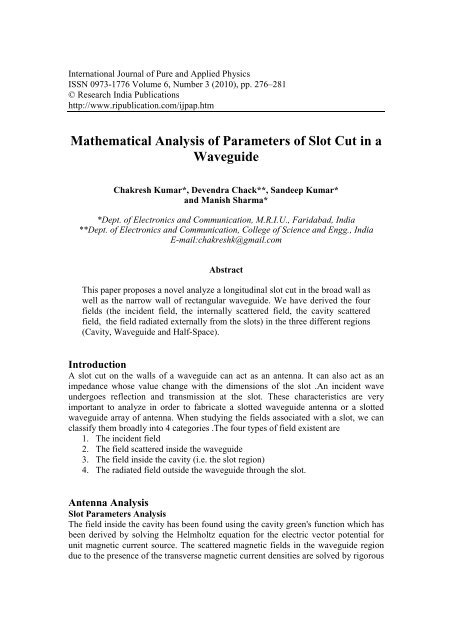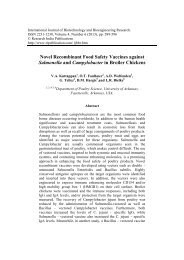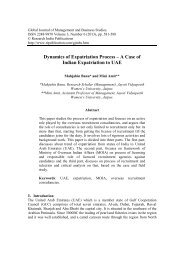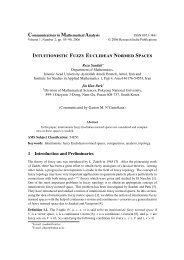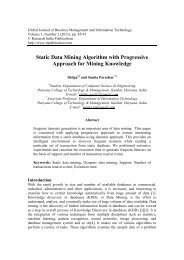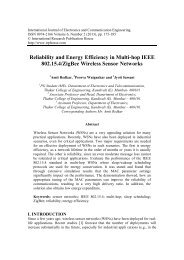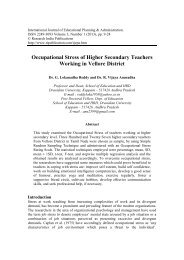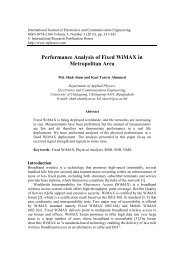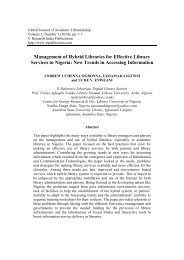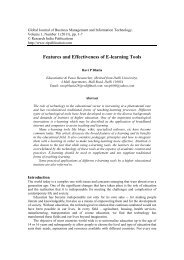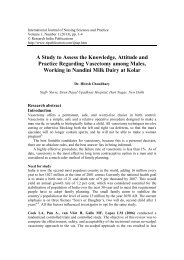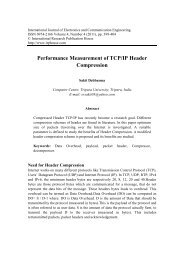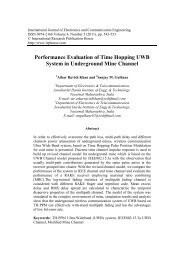Mathematical Analysis of Parameters of Slot Cut in a Waveguide
Mathematical Analysis of Parameters of Slot Cut in a Waveguide
Mathematical Analysis of Parameters of Slot Cut in a Waveguide
You also want an ePaper? Increase the reach of your titles
YUMPU automatically turns print PDFs into web optimized ePapers that Google loves.
International Journal <strong>of</strong> Pure and Applied PhysicsISSN 0973-1776 Volume 6, Number 3 (2010), pp. 276–281© Research India Publicationshttp://www.ripublication.com/ijpap.htm<strong>Mathematical</strong> <strong>Analysis</strong> <strong>of</strong> <strong>Parameters</strong> <strong>of</strong> <strong>Slot</strong> <strong>Cut</strong> <strong>in</strong> a<strong>Waveguide</strong>Chakresh Kumar*, Devendra Chack**, Sandeep Kumar*and Manish Sharma**Dept. <strong>of</strong> Electronics and Communication, M.R.I.U., Faridabad, India**Dept. <strong>of</strong> Electronics and Communication, College <strong>of</strong> Science and Engg., IndiaE-mail:chakreshk@gmail.comAbstractThis paper proposes a novel analyze a longitud<strong>in</strong>al slot cut <strong>in</strong> the broad wall aswell as the narrow wall <strong>of</strong> rectangular waveguide. We have derived the fourfields (the <strong>in</strong>cident field, the <strong>in</strong>ternally scattered field, the cavity scatteredfield, the field radiated externally from the slots) <strong>in</strong> the three different regions(Cavity, <strong>Waveguide</strong> and Half-Space).IntroductionA slot cut on the walls <strong>of</strong> a waveguide can act as an antenna. It can also act as animpedance whose value change with the dimensions <strong>of</strong> the slot .An <strong>in</strong>cident waveundergoes reflection and transmission at the slot. These characteristics are veryimportant to analyze <strong>in</strong> order to fabricate a slotted waveguide antenna or a slottedwaveguide array <strong>of</strong> antenna. When study<strong>in</strong>g the fields associated with a slot, we canclassify them broadly <strong>in</strong>to 4 categories .The four types <strong>of</strong> field existent are1. The <strong>in</strong>cident field2. The field scattered <strong>in</strong>side the waveguide3. The field <strong>in</strong>side the cavity (i.e. the slot region)4. The radiated field outside the waveguide through the slot.Antenna <strong>Analysis</strong><strong>Slot</strong> <strong>Parameters</strong> <strong>Analysis</strong>The field <strong>in</strong>side the cavity has been found us<strong>in</strong>g the cavity green's function which hasbeen derived by solv<strong>in</strong>g the Helmholtz equation for the electric vector potential forunit magnetic current source. The scattered magnetic fields <strong>in</strong> the waveguide regiondue to the presence <strong>of</strong> the transverse magnetic current densities are solved by rigorous
<strong>Mathematical</strong> <strong>Analysis</strong> <strong>of</strong> <strong>Parameters</strong> <strong>of</strong> <strong>Slot</strong> <strong>Cut</strong> <strong>in</strong> a <strong>Waveguide</strong> 277mode match<strong>in</strong>g technique. The scattered field <strong>in</strong>side the waveguide due to slots <strong>in</strong> thebroad / narrow wall <strong>of</strong> the waveguide has been derived us<strong>in</strong>g the Green’s function forthe electric potential for such a slot. From the field exist<strong>in</strong>g at the aperture fed by awaveguide, the radiated field can be evaluated us<strong>in</strong>g plane wave spectrum approach.The radiated field is obta<strong>in</strong>ed by expand<strong>in</strong>g the spherical waves <strong>in</strong> terms <strong>of</strong> planewave spectrum <strong>in</strong> the vector potential formulation. By apply<strong>in</strong>g the cont<strong>in</strong>uitycondition <strong>of</strong> the tangential magnetic field at the slot, and expand<strong>in</strong>g the unknownmagnetic current densities <strong>in</strong> terms <strong>of</strong> piecewise l<strong>in</strong>ear (triangular) / entire doma<strong>in</strong>s<strong>in</strong>usoidal basis function by us<strong>in</strong>g the Method <strong>of</strong> Moments, the problem is reduced tosolv<strong>in</strong>g the simultaneous l<strong>in</strong>ear equations.Derivation <strong>of</strong> Scattered Fields <strong>in</strong> Cavity, Half-Space and <strong>Waveguide</strong> due toApertures and <strong>Slot</strong>sThe expressions for the scattered field <strong>in</strong>side a cavity due to magnetic current sourceat the aperture has been derived from cavity Green’s function <strong>of</strong> the electric vectorpotential. The field radiated <strong>in</strong>to half space by the magnetic current source at theaperture is obta<strong>in</strong>ed us<strong>in</strong>g the spectral doma<strong>in</strong> approach. The expressions for scatteredfields <strong>in</strong>side the waveguide due to rectangular slots cut on the broad / narrow walls <strong>of</strong>the rectangular waveguide are derived us<strong>in</strong>g the vector potential approach.Derivation <strong>of</strong> the Field Radiated <strong>in</strong>to Free Space by a Rectangular ApertureFrom the field exist<strong>in</strong>g at the aperture fed by a waveguide, the radiated field can beevaluated us<strong>in</strong>g the plane wave spectrum approach [8, 98, 100]. The radiated field isobta<strong>in</strong>ed by expand<strong>in</strong>g the spherical waves <strong>in</strong> terms <strong>of</strong> plane wave spectrum <strong>in</strong> thevector potential formulation.The components <strong>of</strong> the magnetic field at the aperture plane are given <strong>in</strong> terms <strong>of</strong>Fourier Transform <strong>of</strong> the aperture electric field as∞∞2 21 kkx yεx+ ( k −k) εx y jkxky ( x + y )follows: Hx =− e dkdkx y2k πη∫∫k−∞−∞z∞ ∞2 21 kkx yεy+ ( k −k) εy x jkx ( x + ky y )Hy = e dkxdky2πηk∫∫k−∞ −∞z∞ ∞1 kkx zεy− kky zεxjkx ( x + ky y )Hz= e dkxdky2πkη∫∫k−∞ −∞zFor any aperture electric field distribution, therefore, the magnetic field at anypo<strong>in</strong>t <strong>in</strong> space can be found out us<strong>in</strong>g the approach outl<strong>in</strong>ed so far. In the rest <strong>of</strong> thisthesis, the required component <strong>of</strong> magnetic field has been determ<strong>in</strong>ed from theseexpressions by us<strong>in</strong>g suitable change <strong>of</strong> axes.
278 Chakresh Kumar et alDerivation <strong>of</strong> the Scattered Field <strong>in</strong>side a <strong>Waveguide</strong> due to a Longitud<strong>in</strong>al <strong>Slot</strong>on the Broad Wall <strong>of</strong> the <strong>Waveguide</strong>Figure 2: Longitud<strong>in</strong>al slot on the broad wall <strong>of</strong> a rectangular waveguideFigure (2) shows a longitud<strong>in</strong>al slot <strong>of</strong> dimension 2L× 2Wcut on the broad wall<strong>of</strong> a rectangular waveguide <strong>of</strong> cross section 2a× 2b. The slot is <strong>of</strong>fset from the broadwall centre l<strong>in</strong>e by x w .If the slot is narrow, the electric field E sexist<strong>in</strong>g <strong>in</strong> theaperture can be approximated asE = uE ˆs x xAnd the equivalent magnetic currentMMsis given by:uˆ xEx × uˆ ˆy= uzE xfor ⎧⎪fields radiated <strong>in</strong>to free space= ⎨× − = −suˆ xEx ( uˆ y)uˆzE xfor fields scattered with<strong>in</strong> waveguide⎪⎩The electromagnetic field radiated by the slot <strong>in</strong>to the waveguide is therefore hasto satisfy the scalar Helmholtz equation, with source . In other words,∇ F + kF=−M2 2z z zThe green’s function is def<strong>in</strong>ed to be the solution <strong>of</strong> the differential equation withthe excitation function Mzbe<strong>in</strong>g a unit impulse. Substitution <strong>of</strong> a delta function forMz, therefore gives,∞ ∞εεm nmπG( x,y,z/ x,y,z ′ ′ ′⎧ ⎫) = ∑∑ cos ⎨ ( x+ a)⎬×m0m0 = = 8γmnab ⎩2a⎭⎧nπ ⎫ −γmnzz − ′ ⎧mπ ⎫ ⎧nπ⎫cos⎨ ( y+ b) ⎬e cos⎨ ( x′ + a) ⎬cos⎨ ( y′+ b)⎬⎩2b ⎭ ⎩2a ⎭ ⎩2b⎭G ( xyz , , / x′ , y′ , z′ ) is the Green’s function for the electric vector potentialfunction for the <strong>in</strong>ternal scattered field due to a longitud<strong>in</strong>al slot on the broad wall <strong>of</strong> arectangular waveguide.Mz
<strong>Mathematical</strong> <strong>Analysis</strong> <strong>of</strong> <strong>Parameters</strong> <strong>of</strong> <strong>Slot</strong> <strong>Cut</strong> <strong>in</strong> a <strong>Waveguide</strong> 279“The same Green’s function holds good for a longitud<strong>in</strong>al slot <strong>in</strong> the narrow wall<strong>of</strong> a rectangular waveguide too”.Derivation <strong>of</strong> the Cavity Scattered FieldWith the cavity Green’s function <strong>of</strong> electric vector potential “F” be<strong>in</strong>g determ<strong>in</strong>ed, thenext step is to f<strong>in</strong>d the scattered magnetic field <strong>in</strong>side the cavity region due to themagnetic currents.Derivation <strong>of</strong> the Externally Radiated FieldThe magnetic field at the plane <strong>of</strong> the aperture (i.e. X-Y plane) is evaluated us<strong>in</strong>g theplane wave spectrum approach.∞ ∞2 2( k −k)ext 1x jkx ( x + ky y )H =− ε ( k , k , k)e dk dk2πηk∫∫kx y x y x y−∞ −∞ zS<strong>in</strong>ce E at the aperture is assumed to only the Y-component, there is no εxterm<strong>in</strong> above equation . The Fourier Transform <strong>of</strong> the electric field at the aperture is givenby equation12π∞∞−∞ −∞∫∫( x ′ ky y ′) ′ ′= ε ( )− jkx+s s x y zE e dxdy k ,k ,kCarry<strong>in</strong>g out the necessary <strong>in</strong>tegration, εyandε2WM2,y( k,k,k) = ∑ E s<strong>in</strong>ckW ( )⎪⎧extHxare obta<strong>in</strong>ed as:( x )( )j s<strong>in</strong> k L for p evencos k L for p odd⎨⎬x⎪⎪⎩⎭y x y p y 2⎫π⎧⎪⎪ ⎞⎛p1 =π 2Lkxp 1 − ⎨2L⎜pπ⎟ ⎬⎪⎫⎝⎠⎪⎪⎩⎭M ∞ ∞ 2 2ext WL 2,y k −kxHx =−2 ∑Ep s<strong>in</strong>c1 ( kWy ) ×π kηp1 = 2 2 2 2−∞ −∞ k k k∫∫( −x−y)( x ) ⎫⎪⎬( x ) ⎪ jkxky { x + y }⎧⎪j s<strong>in</strong> k L for p even⎨⎪⎩cos k L for p odd ⎭2 e dkdkxpπ⎧⎪⎛2Lk1x⎞ ⎫⎪⎨ −2⎜ ⎬pπ⎟⎪⎩⎝ ⎠ ⎪⎭Derivation <strong>of</strong> the Externally Radiated FieldThe plane wave spectrum approach, is used to determ<strong>in</strong>e the magnetic field at the slot,due to the electric field exist<strong>in</strong>g at the slot aperture. For the Z-component <strong>of</strong> they
<strong>Mathematical</strong> <strong>Analysis</strong> <strong>of</strong> <strong>Parameters</strong> <strong>of</strong> <strong>Slot</strong> <strong>Cut</strong> <strong>in</strong> a <strong>Waveguide</strong> 281ConclusionThe necessary equations have been derived for basically 4 fields associated with thewaveguide and the slot. Namely, the <strong>in</strong>cident field, the <strong>in</strong>ternally scattered field due tothe magnetic current , the cavity scattered field and the field radiated externally fromthe slots. After this extensive theoretical understand<strong>in</strong>g the task <strong>of</strong> f<strong>in</strong>d<strong>in</strong>g theequivalent circuit parameters has been handled.References[1] Liang. J. F., Chang. H. C. and Zaki. K. A., “Design And Tolerance <strong>Analysis</strong>Of Thick Iris <strong>Waveguide</strong> Bandpass Filters,” IEEE Transactions on Magnetics,Vol. 29, No. 2, pp. 1605-1608, March 1993.[2] Ol<strong>in</strong>er, A.A., “The Impedance Properties Of Narrow Radiat<strong>in</strong>g <strong>Slot</strong>s In TheBroad Face Of Rectangular <strong>Waveguide</strong>. Pt. 1-Theory. Pt. 2- ComparisionWith Measurement”, IRE Transactions on Antennas and Propagation, Vol.AP-5(1), pp. 4-20, 1957.[3] Das, B.N. and Sanyal, G.S., “Network <strong>Parameters</strong> Of A <strong>Waveguide</strong> BroadWall <strong>Slot</strong> Radiator”, Proc. IEE, Vol.117, No.1, pp.41-44, 1970.[4] Prasad, S.M. and Das, B.N., “Studies On <strong>Waveguide</strong> Fed <strong>Slot</strong> Antenna”, Proc.IEE, Part H, Vol. 120, No. 5, pp. 539-540, 1973.[5] Das, B.N. and S<strong>in</strong>ha, M., “Admittance Characteristics Of Longitud<strong>in</strong>al <strong>Slot</strong>sIn The Broad Wall Of Rectangular <strong>Waveguide</strong>”, JIETE (India), Vol. 21, pp.32-37, January 1975.[6] Bailey. M. C., “Design <strong>of</strong> Dielectric-Covered Resonant <strong>Slot</strong>s In A Rectangular<strong>Waveguide</strong>,” IEEE Transactions on Antennas and Propagation, Vol. 15, No. 5,pp. 594-598, September 1967.[7] Yee, H.Y, “Impedance <strong>of</strong> Narrow Longitud<strong>in</strong>al Shunt <strong>Slot</strong> In A <strong>Slot</strong>ted<strong>Waveguide</strong> Array”, IEEE Trans. on Antennas and Propagation, Vol. AP-22,pp. 589-592, July 1974.[8] Bailey, M.C., “The Impedance Properties <strong>of</strong> Dielectric Covered NarrowRadiat<strong>in</strong>g <strong>Slot</strong>s on the Broad Face Of A Rectangular <strong>Waveguide</strong>”, IEEETrans. on Antennas and Propagation, Vol. 18, pp. 590-603, 1970.
282 Chakresh Kumar et al


